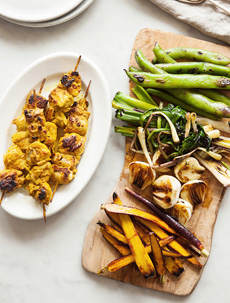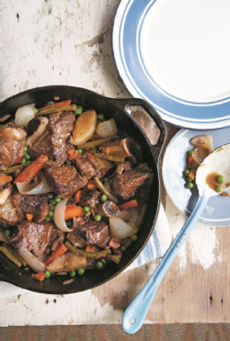TIP OF THE DAY: Stovetop Kabobs In A Cast Iron Pan
|
Who needs a grill to make kabobs? With the recipe below from Good Eggs, you can make delicious and healthful kabobs on the stovetop, using a cast iron pan to char the meat. A hot cast iron pan yields all of the smoky flavor of a grill—and a lot more. THE HISTORY OF CAST IRON COOKWARE Cast iron vessels have been used for two thousand years. The first known use was during the Han Dynasty in China, 206– 220 C.E. Cast iron cookware was prized for its durability and ability to retain heat—a challenge when cooking in a hearth or an even iffier open fire (the kitchen stove was not created until the mid-19th century). The original cast-iron vessels were cauldrons and pots. The flat cast iron skillet as we know it appeared in the late 19th century. While cast iron cookware was popular among home cooks during the first half of the 20th century—along with affordable aluminum and expensive copper—the second half led to stainless steel, less durable and flexible but more attractive. Even more attractive and less durable was the pricier enamel-coated cast iron, like Le Creuset (the enamel coating will chip if dropped and can’t be repaired). Nonstick, easy to clean Teflon-coated cookware became the choice of housewives beginning in the late 1960s, although cast iron, copper and stainless continued to be used in professional kitchens. Here’s a longer history of cookware, which began with animal hides in prehistoric times. And they’ll endure forever. Ours was purchased by our grandmother in the 1920s! Today, a 15-inch cast iron skillet, large enough for steaks and chops, is $40. Cast iron skillets are available from the petite (6 inches in diameter) to the jumbo (17 inches). Lodge, a top producer of cast-iron cookware, sells them in one-inch increments (6, 7, 8, 9, etc). Lodge-brand pans, our favorites, are pre-seasoned and ready-to-use, eliminating the main objection to buying cast iron. In addition to a lifetime of service for an affordable buy-in, cast iron: |

|
|
|
|
||

|
RECIPE: YOGURT-MARINATED CHICKEN KABOBS WITH INDIAN SEASONINGS
Feast on tender chicken and charred vegetables. Prep time is just 20 minutes, and you can marinate the chicken overnight. This dish pairs well with a side of grains—ideally whole grains (barley, brown rice, bulgur, quinoa, etc.), but is fine with good old, less nutritious white rice. For The Chicken & Marinade Three of the four vegetables here are spring vegetables. You can substitute any veggies you like. †Spring onions are not the same as green onions (a.k.a. scallions). Spring onions are immature onions, harvested early in the season. They are milder than regular onions. You can substitute sweet onions or shallots.( |
|
|
Preparation 1. PREHEAT the oven to 400°F. Place the bamboo skewers in a large bowl of water and soak for 5 minutes. (Or cook the chicken without skewers. It will taste the same, but skewers are a more special presentation.) Mix the marinade ingredients in a large bowl, add the chicken and toss to combine. 2. THREAD five cubes onto each skewer. You can do this in advance and store the prepped kebabs in the fridge for up to 24 hours. 3. HEAT a large cast-iron skillet, then add enough two tablespoons of olive oil, or as much as you need browning. Brown the chicken on all sides, about 2 minutes per side; then place the entire pan into the oven. Bake for 5 minutes or until the internal temperature of the chicken is 165°F. Remove the kebabs from the skillet and set aside. 4. HEAT a second large pan (or wipe the first pan clean), adding the olive oil when the pan is very hot. Add the vegetables in one layer without crowding (cook in two batches if necessary). Cook for 2-3 minutes, then flip and cook for another 2-3 minutes. When the vegetables are a bit tender, very browned and (hopefully) a bit charred, remove them from the pan. Dress with a squeeze of lemon and a pinch of salt, and serve alongside the kabobs.
|
||




